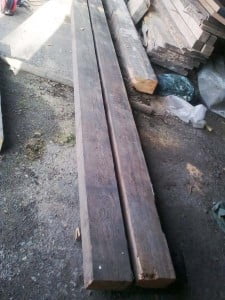This is a blog by Stuart Clachan of Clachan Wood in Ayrshire who designs and makes bespoke handmade furniture as well as doing furniture restorations.
Stuart was a Chippendale School student in 2009 and came 2nd in the ‘Triton Woodworker of the year 2011’ competition (sponsored by GMC Publication’s Furniture and Cabinetmaking magazine).
It’s not every day you are asked to submit a design proposal for an ‘A’ listed building, Kirkoswald Church, that is the only Church in Scotland Robert Adam worked on. The brief was to design, make and fit a balustrade for the steps leading up to the pulpit and round a wee landing. As soon as I saw the pulpit I realised that a simple hand rail would not do the pulpit or the church any justice at all.
So, I proposed what I thought was a good solution picking up on the existing moulding and turning details without thinking too much about how it would be made. It was a strange situation as the steps leading to the pulpit had never had a hand rail – much to the surprise of building control.
The decision to add it meant a lot of details would have to be considered in order to get the hand rail height and newel post design to look correct with regard to the existing work; as I would find out later.
The hunt for pitch pine
In my proposal to the church I suggested that it would be appropriate to use pitch pine to match the existing wood. The hunt was now on to find pitch pine which as it turns out is not particularly easy to track down. After a number of weeks of phone calls I found some reclaimed pitch pine 8”x5” beams which were taken out of an old mill, bought them and had them delivered to the workshop as some of them were 27’ long – too big to get in the van.

Although I had approximately 50% more than required some beams had shakes and others had knots etc and I knew that the grain had to be quarter sawn. One week, 6 band saw blades, a circular saw blade and some planer blades later I had almost all of the different sections required to make the spindles, hand rail, mouldings and flat boards. Although pitch pine smells amazing when cut it is very hard on machinery.
Following that I used Anselm’s version of technology and phoned a moulding company to run all the mouldings, apart from a few that I hadn’t decided on or could make myself. The spindles were also sub-contracted out as my lathe isn’t big enough so a design and the machined blanks were given to a chap with a copy lathe.
Once all of the machined components arrived back at the workshop I had a good think about it for about a month or two (whilst working on other jobs), did a number of scale drawings and eventually decided to make a start. The newel posts are hollow with solid timber where fixings were required.
Using good old animal glue
In order to get a repeatable dimension for the moulding work on the newel post a jig was made to sit the basic square in. The mouldings were mitred and fitted using good old animal glue which was chosen for its quick drying time. Each newel post has about 70 mitres given that all four faces had to be covered.
The diamond detail proved to be fairly challenging and is a testament to the craftsmen who made the original woodwork, suffice to say a number of jigs were made. Rub joints were used to create twenty four ‘V’ shapes (with a few spares) which were slightly easier to fit than they would have been individually.
After the diamond details were finished it was a case of adding the remaining mouldings to the top and bottom as once they were on the newel posts became more difficult to move.
Everything was cleaned up and given a few coats of white polish to stop finger prints and left at that. The existing woodwork is quite time worn and having a shiny new balustrade would be too much of a distinction between old and new. In a few years the sun will darken the balustrade to a closer match to the original woodwork.
Templates were made to mark the exact positions of the newel posts at the church. After a whole lot of cutting, measuring, looking, measuring, looking again, looking from a different angle and finally fixing, the newel posts were fitted at the church.
A basic pine hand rail for the steps was fitted to get the exact length and angle for the actual hand rail as I had only just enough material to do the job and couldn’t afford to make a mistake.
The pitch pine hand rail was then fitted using the first one as a template and a deep sigh of relief could probably be heard all over Ayrshire as everything else was fairly straightforward after that.
Mission accomplished: some of the congregation didn’t even notice!

On reflection it was a very satisfying job to work on and something I may never get the opportunity to do again. It has been well received by the congregation and a number of people did not even notice the balustrade as they thought it had always been there, which is possibly the biggest compliment I could get.
If you’re a Chippendale alumni and have a story you’d like to share, please contact us with your blog or idea. We hear how it’s going.
